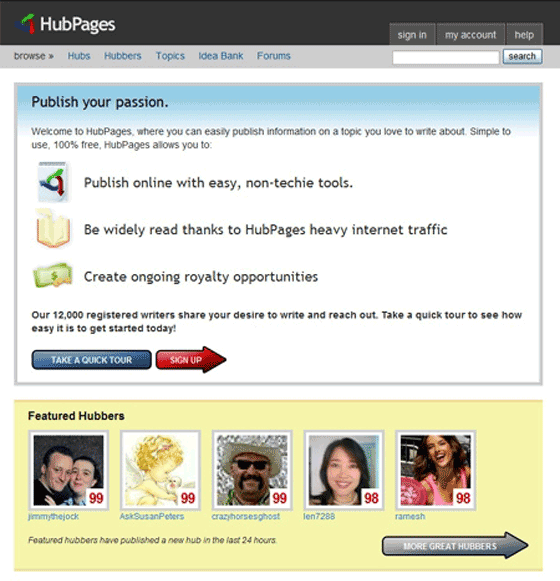 San Francisco based HubPages, a revenue sharing community content destination, debuts a new look and ad yield technology today, building on a portal that is now attracting 2.4 million unique visitors a month.
San Francisco based HubPages, a revenue sharing community content destination, debuts a new look and ad yield technology today, building on a portal that is now attracting 2.4 million unique visitors a month.
We’ve previously covered HubPages here and here: the company took $2 million in funding from Hummer Winblad in August 2006 and on its initial launch in February 06 Michael Arrington asked the question as to whether HubPages was a better Squidoo.
The team behind the service has a particularly strong heritage: CEO Paul Edmondson was previously the Group Product Manager for MSN Entertainment, Jay Reitz was the Development Manager, and Paul Deeds was a developer in Windows Media Internet Services.
The new look follows extensive community consultation with over 14,000 authors across 20,000 hubs. On top of the visible changes that will be evident to the casual visitor, HubPages has included support for slide shows and multiple pictures, forums, and hub grouping tools that allow for easier navigation.
On the advertising side, HubPages officially launches what it’s calling “Behavioral Formatting Yield Optimization” technology. In layman’s terms it works out where advertising works best on each hub and places the ad unit to suit.
I spoke to Paul Edmondson ahead of the announcement. He told me that they currently have a handful of publishers making in excess of $1000 a month from their hub pages, with the top publisher currently making $1800/ month. Although by no means full time incomes, for the average writer these are good figures, decent pocket money for those looking to make money online from writing as a part time pursuit.
The newly announced “Behavioral Formatting Yield Optimization” technology has already resulted in an increase in advertising returns of up to 43% averaged across the board in testing to date.
HubPages currently utilizes advertising from Google Adsense, Commission Junction, Amazon and the beta of eBay’s Contextual Advertising units, with plans to roll out direct sponsorships of hubs in the foreseeable future.
There’s a lot to like about this service. The revenue sharing model is generous compared to others; a straight 50/50 60/40 split compared to Squidoo’s 50% of profits only, and publishers are paid direct by the advertiser: advertisements are rotated 1:1 with each publisher’s code and HubPages’ code. The question of Intellectual Property Rights is straight forward: publishers own the content and can do with it as they please.
Having worked in the blogging industry, both as a blogger and blog network owner, I can’t help but think that this is a better model than many blog networks out there currently offer. The flexibility and open nature of content creation at HubPages is a solid idea, the need to deal with payments is gone, and the positive word of mouth from those users making money from the service is bound to drive future growth.
